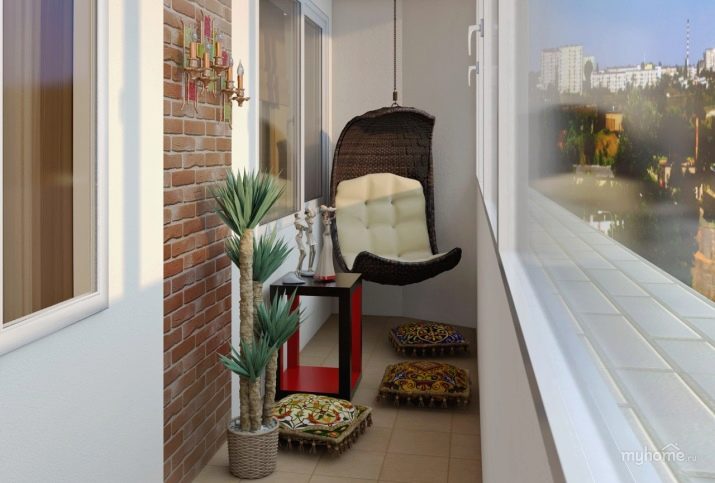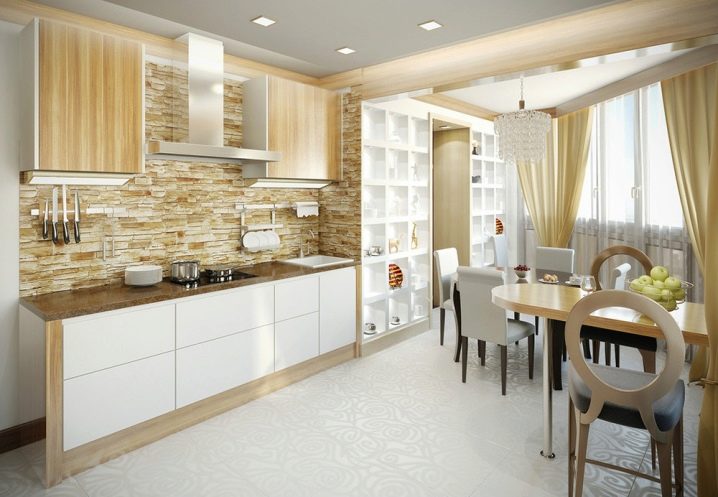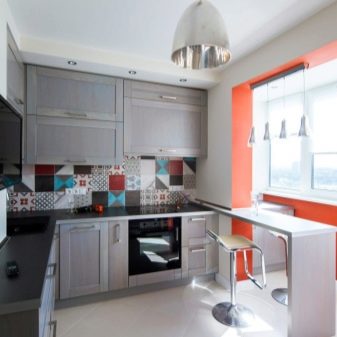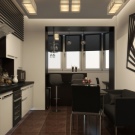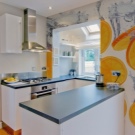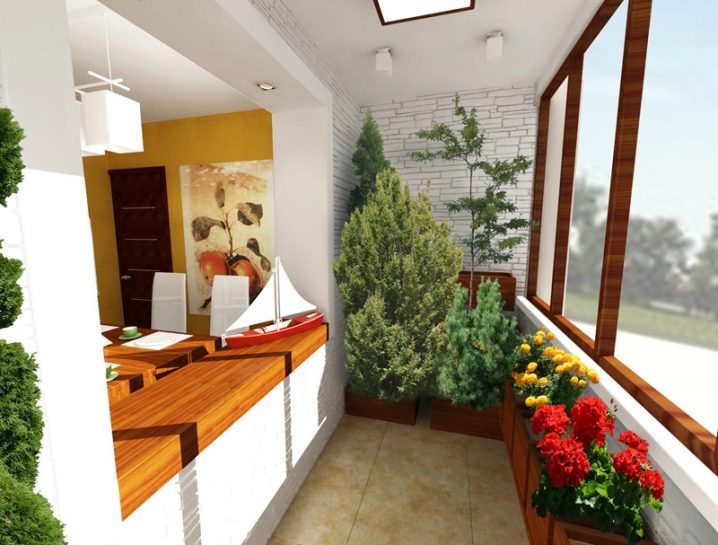Arrangement of loggias
Loggia or balcony - that part of the apartment, which many Russians are used to perceive only as a warehouse of boxes and pickles. Few people imagine what these couple of meters can be turned into. Loggia can be an excellent independent room, summer kitchen or a place of rest, the main thing is to try a little.
Loggia and balcony: what's the difference?
Of course, it is impossible to talk about the arrangement of a room without knowing what it is. For example, many people call the loggia just a balcony. Of course, at first glance, these two designs are very similar - but if you go deeper, it becomes clear that the differences are significant. The ability to distinguish the loggia from the balcony will help not only to properly equip the nook, but also to avoid mistakes when buying an apartment.
Loggia - from the Italian "loggia" room. A balcony - from the German "balko", a ledge. Even the translation of definitions gives some notion of differences.
Balcony - hinged construction with fencing, protruding from the wall.It acts as a so-called beam from the wall, hanging above the ground, held by special fixings.
Loggia is in the room. This is, in fact, the same room, only on the fourth wall it most often has a row of windows. Thus, it can be understood that the first difference is that it adjoins the wall.
The second is that the balcony has three open sides facing the street. They are secured with metal fences. With a room near the balcony is bordered by one wall.
The loggia is exactly the opposite - one side to the street, the other three - to the house. At the corner loggias two parts are located on the street.
Since the balcony is a hinged structure, it has some limitations on the carrying capacity. Roughly speaking, it is extremely inconvenient to carry out repair work on the balcony. In contrast to the loggia. The loggia can be warmed, decorated or installed there any furniture - this room will withstand everything. Equipping a loggia with your own hands is not as difficult as it seems at first glance.
Of course, you can not ignore the dimensions. Balcony - a compact room, clearly limited in size. The area of the loggia can be changed at its discretion, to complement - as with any room.
We can safely say that the main feature of the loggia is in its differences from the balcony. It can also be glazed or not.
Arrangement
When arranging the loggia should be cleaned it from all things and debris. After cleaning is traditionally glazing procedure. In order to properly conduct it, you need to understand how and at what time of year the room will be used.
Glazing
The first thing you should pay attention to when arranging a loggia is of a closed or open type. The first type includes glazed balconies, and they, in turn, are divided into several more:
Under the warm glazing have in mind a complete protection from all natural scourges - winds, cold, as well as noise and street dirt. It is performed, most often, with plastic windows. Of course, thermal insulation and tightness can be attributed to the huge advantages of warm glazing. Plastic windows - running goods on the market, so finding the desired shape and shade is quite possible. However, it was not without flaws. Frames made of PVC and glass are heavy, so they can be used only on tested plates.The frame has a large width, which prevents the penetration of light - slightly, but nonetheless. And the swing-out mechanism of the valves can visually reduce and clutter the room.
Cold glazing is a warming of all parts of the loggia so that it can be used only in the warm season. Such glazing will not save from the winter cold and, in principle, strong winds, as it has insufficient heat and sound insulation. It is usually performed with aluminum frames. Aluminum constructions are easy to install independently; they are light and do not add “weight” to windows. Aluminum is amenable to painting, and its frames are sold in different colors.
Aluminum frames are environmentally friendly, and also durable - 3 times stronger than wood, 7 - plastic.
Separately, it is necessary to consider such a question as the change of cold glass to warm. Many are concerned about the question whether it is possible to carry out this procedure without harm to the plates. Yes, it is quite possible. The main difficulty here is the removal of old windows. Experienced users can try to do it yourself, however, strongly recommends calling the wizard, or at least consult with him.
We must not forget about such a moment as semi-warm glazing. This is, in fact, a slightly simplified version of warm glazing - only the doors here have a sliding mechanism, that is, tightness and thermal insulation just below. It is made of the same PVC frames, only with sliding doors. It is much lighter than warm, and the load on the plates in his case is minimal. Thanks to the semi-heated glazing, it is possible to solve the problem of massive windows and the load on the brackets. This is an ideal option for home or apartments with weak balcony tiles.
Waterproofing
The next stage is waterproofing. In other words - protection of supporting structures and building materials from the harmful effects of water. Indeed, during the rain, moisture can easily get into the most remote corner of the balcony. This problem is especially relevant for owners of loggias on the upper floors.
- Independently perform waterproofing loggia really only from the inside, for external treatment should contact a specialist at least for the sake of their own safety. The process of waterproofing itself lies in the fact that mastic creates a protective layer, and due to the sealant, restoration of damaged parts of concrete occurs.
- Coating compounds require screed on top, and penetrants are considered the most reliable and restore strength to 20%. But they are used only for concrete. But the coating materials from polymers and non-polymers are unpopular, although also reliable - just messing with them is much more than with other compounds.
- Floor waterproofing is a separate issue. The first step is to perform a concrete screed. This can be done in three ways - depending on the seams.
- Compensation method, or temperature. It takes place when laying the pressure layer.
- Forced seams divide the tie into even parts.
- The wall layer is located at the junction of the balcony wall to the facade.
- After the seams need to be filled with sealing mastic with an elastic cord. Sheets of foam are put on top.
A primer is applied to the dust cover. You can pay attention to the primer WB.
Waterproofing should apply to the wall - but literally up to 200 mm. To do this, foil polystyrene is suitable, which is glued to the wall with a cloth. In the case of walls, it is worth applying two layers of mastic, and sealing the joints between the sheets.Next - a decorative coating, for example, a large-relief or small-relief plaster.
Warming
The final stage of the arrangement of the loggia is its warming. Most often, all parts of the room are warmed - walls, ceiling and floor. As well as the previous two stages, it is quite possible to do it yourself. You just need to decide on the material.
- Styrofoam. Available in the form of plates with a thickness of 2 to 10 cm. It has a low price and high popularity.
- Penofol. It is used in combination with penoplex. The material of the newest generation consists of polyethylene foam and aluminum foil.
- Penoplex. Much more expensive than his fellows above - but the quality is different. Available in sheets of 2, 3, 5 and 6 cm. Light and non-capricious in work, has good thermal insulation properties. When working with it requires a flat clean surface - it is screwed to it with special screws.
- Mineral wool. It resembles the usual medical cotton. Possesses heat-insulating and water-repellent properties. Unlike penoplex, capricious in work, barbed, but can penetrate into the farthest corner. Available in rolls and sheets.
- Expanded clay. This is the easiest way.It is light and durable, cheap, not capricious in laying - just falling asleep on the floor surface.
As for the insulation of the ceiling, the same materials are suitable here as for the floor - with the exception of expanded clay. As in the case of walls and floors, the ceiling needs to be checked for holes and gaps before insulation - if they are present, they must be sealed with foam. Otherwise, fungus or mold may form.
But the walls of the loggia are recommended to insulate the penoplex. First of all, you should pay attention to the walls bordering the street. With the help of dowels attached heat insulator. Above - a film as a waterproofing, after - a plaster grid. Now you can take up the plaster. If we are talking about working at heights, then it will be safer to call specialists.
If there is a possibility, we advise you to install a heating system - for example, a floor heating system. This innovation will help to turn a loggia into a real sleeping place - even in winter the cold here will not be terrible.
Finish
After a full arrangement, you can think about the interior decoration. As a rule, the material for it is selected based on the personal preferences of each, the price,but you should not forget about the practical side of the issue.
Floor. An excellent option for finishing the floor would be laminate, carpet or tile. If you wish, you can sketch carpets on top - for comfort and warmth first. Although, again, in the presence of a system of warm floors additional floor finishing is not required.
Ceiling. Most often sheathed clapboard (if suspended) or drywall, or just whitened.
Walls. Plastic panels will be an excellent option for interior walls, but also do not forget about wood or PVC wall paneling. But vinyl siding is suitable for those who want to save.
When all the individual works and works on the arrangement of the loggia are completed, you can think about filling this area with furniture and decorative accessories.

